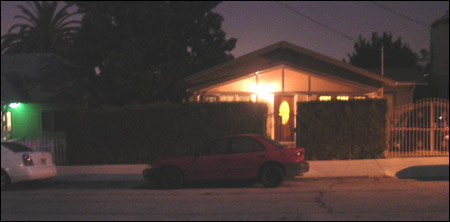Earlier this month, researchers performed a test run of a bus that basically drives itself. It follows a line of magnets embedded in the pavement, coursing exactly along its route and eventually to the bus stop. The tiny magnets on the bus and in the street guide the bus to the perfect parking position at the stop for picking up passengers. It's a cool idea, and a lot of transit agencies are interested. But there are wider applications. Take, for example, my neighborhood, where nobody knows how to park.
Earlier this month, researchers performed a test run of a bus that basically drives itself. It follows a line of magnets embedded in the pavement, coursing exactly along its route and eventually to the bus stop. The tiny magnets on the bus and in the street guide the bus to the perfect parking position at the stop for picking up passengers. It's a cool idea, and a lot of transit agencies are interested. But there are wider applications. Take, for example, my neighborhood, where nobody knows how to park.
If a bus can park itself at a bus stop automatically, why couldn't a car automatically park itself on a street? This magnet bus idea seems simple enough to translate. Let's examine:
The new magnet bus, a project of researchers at the University of California, Berkeley, uses a computer system to sense the subtle directing of small magnets along the intended path of the bus. The computer's detection of these magnetic forces controls a motor attached to the steering wheel of the bus. A human driver has to control the speed and the brakes, but can be literally hands-off while the bus follows the precise path laid out by the magnets -- which are apparently no stronger than the pizza joint fridge magnet that's holding up your kid's report card.
The project has received funding from the state of California and the U.S. Department of Transportation, and could be operational in a public bus system by 2010. It would probably work best on a dedicated bus lane, and that's what the researchers are going for. But even if it couldn't go the whole route, having just the approach to the bus stop magnetized would make the ride a lot more efficient. Anyone who's gotten on a bus (especially those in wheelchairs) knows that the marked bus stop is only a suggestion. Buses typically pull to their stops in slightly different places, and with varying distances from the curb. This variability, say the researchers, creates delays. With their magnet system, the bus pulls up to the exact same spot, a half-inch from the curb, every time.
If only people could park their cars so reliably.
The picture below was taken right next door to my house in Los Angeles and is a perfect example of why this magnet technology is needed on our streets.

The driver of this car was lucky enough to find a spot in my neighborhood, where a three-block post-parking walk home is a way of life. But this driver's sloppy parking job actually takes up two spaces when only one is needed. If there were some of those magnets embedded in the ground here, the car could have been guided into place closer to the driveway behind, leaving room for another car to park in front. Maybe even mine.
Cars, however, do come in different sizes. Setting up a magnet-guided, predetermined parking spot for them all is not exactly reasonable; a Bug has different needs than a Hummer. But with magnets in the street and magnets on cars, couldn't those attractive and repellant forces be harnessed somehow to tell an on-board computer to guide that Bug 6 inches from a driveway or a foot from that Hummer's bumper? If they can park a bus a half-inch away from a curb, there's got to be some magnetic magic they can pull to get this Chevy Cavalier six feet closer to my neighbor's driveway -- and my car right in front.
As someone who primarily rides the bus, though, I'd say any innovation to public transit should be focused on first, before the private automobile. But plenty of people do drive, and most of them can't park, so there's a market out there. Magnetized bus transit would be awesome, but magnetized car parking would probably have a much broader positive impact.
For further explanation of this concept, please consult the video below:

Planetizen Federal Action Tracker
A weekly monitor of how Trump’s orders and actions are impacting planners and planning in America.

Chicago’s Ghost Rails
Just beneath the surface of the modern city lie the remnants of its expansive early 20th-century streetcar system.

Amtrak Cutting Jobs, Funding to High-Speed Rail
The agency plans to cut 10 percent of its workforce and has confirmed it will not fund new high-speed rail projects.

Ohio Forces Data Centers to Prepay for Power
Utilities are calling on states to hold data center operators responsible for new energy demands to prevent leaving consumers on the hook for their bills.

MARTA CEO Steps Down Amid Citizenship Concerns
MARTA’s board announced Thursday that its chief, who is from Canada, is resigning due to questions about his immigration status.

Silicon Valley ‘Bike Superhighway’ Awarded $14M State Grant
A Caltrans grant brings the 10-mile Central Bikeway project connecting Santa Clara and East San Jose closer to fruition.
Urban Design for Planners 1: Software Tools
This six-course series explores essential urban design concepts using open source software and equips planners with the tools they need to participate fully in the urban design process.
Planning for Universal Design
Learn the tools for implementing Universal Design in planning regulations.
Caltrans
City of Fort Worth
Mpact (founded as Rail~Volution)
City of Camden Redevelopment Agency
City of Astoria
City of Portland
City of Laramie





























